Selected pictures
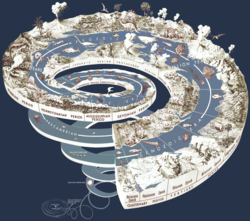
A diagram of the geological time scale, depicted as a spiral and exhibiting the life forms and environmental conditions characterizing its various divisions.
Image credit: Joseph Graham, William Newman, and John Stacy for the United States Geological Survey
Upload credit: Mwtoews

A skeleton of Steneosaurus, an extinct genus of teleosaurid crocodyliform from the Toarcian Lower Jurassic of Holzmaden, Germany.
Photo credit: Didier Descouens

An specimen of the brachiopod Liospiriferina rostrata. Brachiopods filtered plankton, using a specialized, spiral-shaped organ called a lophophore. This specimen is about 35 × 30 mm in size and dates back to the Pliensbachian age of the Jurassic period in France.
Photo credit: Didier Descouens
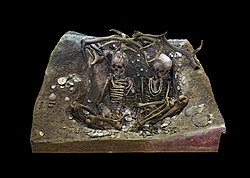
Two skeletons of women between 25 and 35 years of age preserved in the Tomb of Téviec. The tomb is dated to the Mesolithic between 6,740 and 5,680 years ago. They died a violent death, with several head injuries and impacts of arrows. The two bodies were buried with great care in a pit half in the basement rock (underlying or country rock) and half in the kitchen debris that covered them. The tomb is protected by antlers. The grave goods include flint and bone (mainly wild boar) offerings and funeral jewelry which is made of marine shells drilled and assembled into necklaces, bracelets and ankle ring. Some of the bone objects have engraved lines. The tomb was recovered in 1938 and restored in 2010.
Photo credit: Didier Descouens

A skull of the Balearian mouse-goat, Myotragus balearicus, seen in left lateral and right semi-profile aspects. This specimen dates back to the Lower Paleolithic to Neolithic between 500,000 and only 5,000 years before the Current Era. It was discovered in the Islands of Majorca, Spain.
Photo credit: Didier Descouens

A cast of the holotype cranium of the Sahelanthropus tchadensis in semi-profile view. This specimen is catalogued as TM 266-01-060-1 and popularly known by the nickname Toumaï.
Photo credit: Didier Descouens

A tooth of Australopithecus africanus catalogued by the Transvaal Museum as STS 1881. The specimen is 15.46 × 13.64 × 7.31 mm in size. STS 1881 was discovered near Sterkfontein, South Africa and dates back 2.8 million years.
Photo credit: Didier Descouens

Skull from one of the women preserved in the Tomb of Téviec. The tomb is dated to the Mesolithic between 6740 and 5680 years ago. They died a violent death, with several head injuries and impacts of arrows. The two bodies were buried with great care in a pit half in the basement rock (underlying or country rock) and half in the kitchen debris that covered them. The tomb was protected by antlers. The grave goods include flint and bone (mainly wild boar) offerings and funeral jewelry. The tomb was recovered in 1938 and restored in 2010.
Photo credit: Didier Descouens

A skeleton of Barracudasauroides panxianensis collected from the ~247.2-million- to ~242-million-year-old Anisian Guanling Formation of Guizhou Province, China. The specimen is 118 × 62 × 545 cm in size and 79.4 kg in mass.
Photo credit: Didier Descouens

A stromatolite collected from the 3,600- to 3,200-million-year-old Paleoarchean Strelley Pool Chert of Western Australia, Australia. Stromatolites are formed over the years by mats (1–10 mm in thickness) of microorganisms (cyanobacteria among others) found in shallow, mainly marine waters. The microorganisms precipitate mineral particles, which makes the mat thicken, but only the upper part survives. Most stromatolites display characteristically layered structures. Only the layers are visible to the naked eye.
Photo credit: Didier Descouens

A fossil of the trilobite Pseudoasaphus praecurrens. This specimen dates back 460–468 million years ago to the Darriwilian age of the Middle Ordovician epoch and was discovered near Saint Petersburg, Russia in the Koporka River deposits. It is 18.4 × 10 × 4.4 cm in size and has a mass of about 580 g.
Photo credit: Didier Descouens
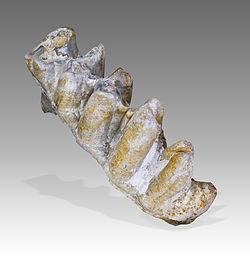
A molar of the proboscidean Platybelodon grangeri. This fossil dates between 5.3 and 14 million years ago to the Miocene epoch of the Neogene period. It was discovered in the Linxia Basin of Gansu Province, China and measures 20 × 9 × 6 cm in size.
Photo credit: Didier Descouens
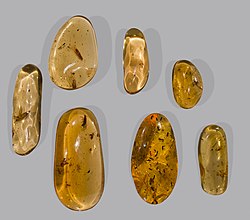
Copal from Madagascar. These specimens bear fossil inclusions including spiders, termites, ants, elaterids, hymenopterans, a cockroach and a flower.
Photo credit: Didier Descouens

Two views of a natural endocranial cast articulated with a fragmentary skull of Australopithecus africanus, which includes the left maxilla, the orbital area and most of the skull base. Its endocranial volume was 485 cm3 (29.6 cu in). This specimen is cataloged by the Transvaal Museum as TM 1511 and was formerly considered the holotype of a separate species, Plesianthropus transvaalensis. It was first discovered in South Africa by G. W. Barlow and described by Robert Broom in 1938.
Photo credit: José Braga and Didier Descouens

A shell trumpet made of the conch species Charonia lampas dating back 10,000 to 17,000 years ago to the Magdalenian stage of the Upper Paleolithic. The specimen is 31 × 18 × 18 cm in size and cataloged by the Muséum of Toulouse as MHNT.PRE.2010.0.1.2. It was discovered in 1931 during field work undertaken by Henri Begouen of the University of Toulouse and J. Townsend Russell of the Smithsonian Institution in the Marsoulas cave of Marsoulas, Haute-Garonne, France.
Photo credit: Didier Descouens

The original 2.1-million-year-old skull of an Australopithecus africanus specimen nicknamed "Mrs. Ples". The specimen was discovered in the Sterkfontein cave, hominid fossil in South Africa and is catalogued by the Transvaal Museum as STS 5.
Photo credit: José Braga and Didier Descouens

Cast of the skull and neck vertebrae of a Uintatherium anceps. The specimen was a gift from Professor Othniel Charles Marsh to the Museum National d'Histoire Naturelle of Paris, France in 1889.
Photo credit: Jebulon
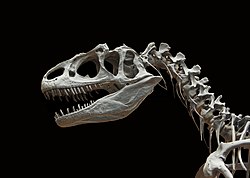
Mounted skull and neck of the 150-million-year-old Late Jurassic theropod Allosaurus fragilis. The specimen was discovered in the U.S. state of Utah and is exhibited in the Galerie de paléontologie et d'anatomie comparée of the Muséum National d'Histoire Naturelle in Paris, France.
Photo credit: Jebulon
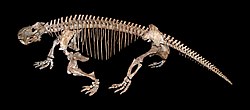
A mounted replica skeleton of the Middle Triassic dicynodontid Tetragonias njalilus from Tanzania. The mount is on display at the Staatliches Museum für Naturkunde in Karlsruhe, Germany.
Photo credit: H. Zell
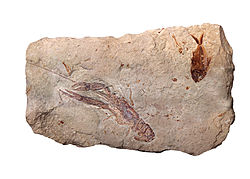
A 95-million-year-old slab of fossiliferous rock from Hakel, Lebanon measuring 24 cm in width. The specimen prominently preserves a member of the lobster genus Pseudostacus as well as the fish Diplomystus birdii A fragmentary specimen of an additional fish, Dercetis triqueter, is visible in the lower right-hand corner of the specimen.
Photo credit: Brocken Inaglory

The mounted lectotype skeleton of the Late Jurassic stegosaur Kentrosaurus aethiopicus in the Museum für Naturkunde of Berlin, Germany. The specimen was a partial 4.5-m-long individual excavated from the "St" quarry at Kindope, Tendaguru, Tanzania.
Photo credit: H. Zell

Rock formations known as the Tepees in Petrified Forest National Park Arizona, USA. The exposed rock layers belong to the Blue Mesa Member of the Chinle Formation and are about 220 to 225 million years old. The colorful bands of mudstone and sandstone were laid down during the Triassic, when the area was part of a huge tropical floodplain.
Photo credit: User:Finetooth
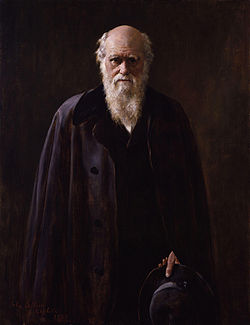
An 1883 copy of an 1881 portrait of Charles Darwin by John Collier. According to Darwin's son Erasmus, "The picture is a replica of the one in the rooms in the Linnaean Society and was made by Collier after the original. I took some trouble about it and as a likeness it is an improvement on the original." The portrait was given to the National Portrait Gallery in London in 1896.
Art credit: John Collier
Upload credit: User:Dcoetzee

A specimen of copal with insect inclusions. The piece of copal measures around four centimeters deep and the insects are trapped from 0.5 to 2 centimeters deep within it. The bubbles around some of the insects indicate that they were alive and breathing when they were trapped inside.
Photo credit: Brocken Inaglory
Upload credit: Mbz1
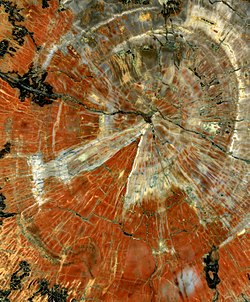
The middle of a polished 15.34 cm × 18.04 cm slice of a petrified tree from Arizona, USA. After the enlargement of the image it is possible to see insect borings in the wood. The tree lived approximately 230 million years ago during the Late Triassic.
Photo credit: Michael Gäbler

Close up image of petrified wood from Canyonlands National Park in Utah, USA.
Photo credit: Jim Gordon

Various views of a shell of the Pliocene snail species Petaloconchus intortus from Baschi, Italy. The specimen is 2.9 cm long.
Photo credit: H. Zell
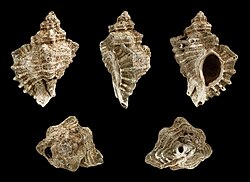
Various views of a Pliocene shell of the European sting winkle Ocenebra erinacea from Bibbiano, Tuscany, Italy. The specimen is 3.3 cm long.
Photo credit: H. Zell

Various views of a Pliocene shell of the lightning whelk Busycon contrarium from La Belle, Florida, USA. The specimen is 24 cm long.
Photo credit: H. Zell

An extremely well preserved specimen of the Late Jurassic ichthyodectid fish genus Thrissops, similar to the species T. formosus. The specimen was discovered near Ettling, Bavaria, Germany and still preserves remains of the animal's soft tissue like musculature and the gastrointestinal tract. Even the color pattern it exhibited in life is preserved as spots by the melanin in its scales.
Photo credit: H. Zell
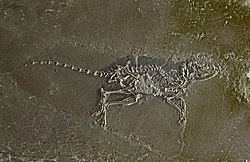
A fossil of the Eocene mammal Macrocranion tupaiodon discovered in Messel, Germany. The specimen is on display at the Museum für Naturkunde in Karlsruhe, Germany.
Photo credit: H. Zell
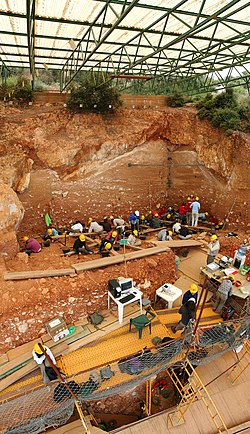
Excavations at a fossil site called Gran Dolina, in Atapuerca, Spain, during 2008. The horizon receiving primary attention of this excavation is called TD-10, which is all that remains of a Homo heidelbergensis camp. Under the plank, a woman in a red sweatshirt is excavating the TD-6 horizon, where the first documented remains of Homo antecessor were discovered.
Photo credit: User:Mario modesto

Fossil remains of various horse genera, showing the evolution of their skeletons, skulls and limb bones over time. The uppermost and most recent genus is that of the modern horse, Equus. Below that is Pliohippus, dating back to the late Miocene. Below that and older still is Merychippus of the middle Miocene. The bottom and oldest horse genus is Mesohippus from the late Eocene.
Photo credit: H. Zell

An ant preserved in a small, roughly 1.5 cm by 2 cm piece of Colombian amber.
Photo credit: Brocken Inaglory

Dusk on the Marine Parade, Lyme Regis, Dorset, UK. The ammonite-design streetlamps reflect the town's location on the Jurassic Coast, a World Heritage Site. The bird is a herring gull, Larus argentatus.
Photo credit: User:MichaelMaggs

A mounted skeleton of a Late Cretaceous mosasaurid species belonging to the genus Plioplatecarpus, probably P. ictericus. In life the animal would have been about 5.5 m in length. The mounted skeleton is actually a composite of two individuals collected from the Niobrara Formation, of Kansas, USA and is exhibited in the Museum für Naturkunde in Karlsruhe, Germany.
Photo credit: H. Zell

A life restoration of the Late Cretaceous ceratopsid dinosaur Achelousaurus horneri from the Two Medicine Formation of Montana, USA.
Artist credit: Mariana Ruiz

Fossil shell of the parkinsoniid ammonoid Parkinsonia parkinsoni. The shell dates back to the Bajocian age of the Middle Jurassic epoch and is about 14.5 cm in diameter. It was collected in Evrecy, France.
Photo credit: H. Zell
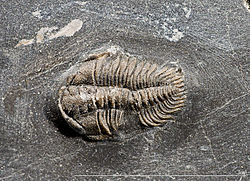
A fossil of the trilobite Pliomerops escoti. This specimen dates back to the Ordovician period.
Photo credit: Didier Descouens

Focus stacked composite of 7 photographs of a trilobite fossil.
Photo credit: Thomas Bresson

A fossil of the asaphid trilobite Megalaspides. This specimen dates back to the Ordovician period. It was collected in Ohio, USA and is displayed by the Staatliches Museum für Naturkunde in Karlsruhe, Germany.
Photo credit: H. Zell

A fossil of a calymenid trilobite.
Photo credit: Thomas Bresson

The top image is a nodule containing a calymenid trilobite fossil. The bottom images show the extracted fossil (right) and the natural mold it left behind in the counterpart section of the nodule (left).
Photo credit: Thomas Bresson

A fossil of the trilobite Koneprusia brutoni. This specimen dates back to the Devonian period and was discovered near Djebel Oufaten, Morocco. The fossil is about 6.5 cm long.
Photo credit: Didier Descouens

Fossil of a trilobite in the genus Niobella resembling the species N. fourneti. This fossil was discovered in Saint-Nazaire de Ladarez, France.
Photo credit: Pierre Selim

A cluster of fossils fossil of the trilobite Homotelus bromidensis. This specimen dates back to the Ordovician period and was discovered in Oklahoma, USA.
Photo credit: High Contrast